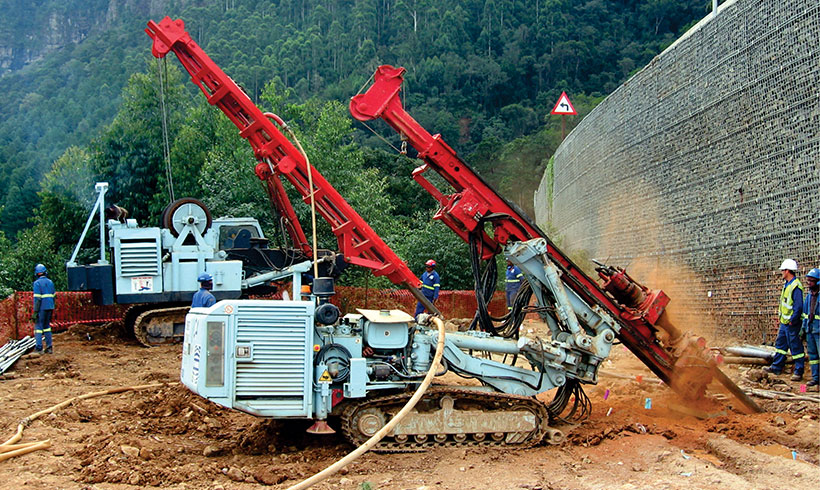The Definitive Guide for Geotechnical Engineering For Construction Projects
The Definitive Guide for Geotechnical Engineering For Construction Projects
Blog Article
All about Geotechnical Engineering For Construction Projects
Table of ContentsSome Known Factual Statements About Geotechnical Engineering For Construction Projects Some Of Geotechnical Engineering For Construction ProjectsGeotechnical Engineering For Construction Projects Fundamentals ExplainedA Biased View of Geotechnical Engineering For Construction ProjectsThe Main Principles Of Geotechnical Engineering For Construction Projects About Geotechnical Engineering For Construction Projects
The role of geotechnical design significantly deals with realizing the features of soil and rock, which might differ considerably by their density, moisture web content etc. These functions should be examined by geotechnical designers to anticipate their motions under different situations. The safety in addition to stability of structures are impacted by dirt problems, making this analysis required.A geotechnical designer will analyze dirt to figure out the bearing capacity of the planet and recommend correct foundation kinds, such as shallow structures, deep foundations like heaps, or specialized remedies like floating foundations for soft dirts. Comprehending the functions and activities of soil and rock, in enhancement to exactly how they communicate with constructions that have actually been erected on or within them, is just one of the key explanations for why geotechnical design is necessary.
Ecological security is completed through geotechnical design. Proficiency in air, water, and soil high quality upkeep is placed to utilize by geotechnical designers to minimize the negative impacts of tasks.
Framework advancement, offshore engineering, passage building and construction, and deep foundations. Risk-based design and multidisciplinary groups. These elements will keep the field progressing and ensure its ongoing relevance in the years to come. To summarize, geotechnical engineering is a vital self-control that protects the resilience and stability of civil framework. Geotechnical designers add to making building projects reliable around the world by comprehending the behaviour of planet products and applying suitable planning strategies.
See This Report about Geotechnical Engineering For Construction Projects
By examining dirt, rock, and subsurface conditions, geotechnical designers give important understandings that aid in the layout, construction, and maintenance of buildings and facilities.

An Unbiased View of Geotechnical Engineering For Construction Projects
Laboratory screening: Establishing the properties of soil and rock. Numerous top-level building projects have actually efficiently utilized geotechnical design to guarantee their security and safety.

As a leader in geotechnical engineering, BECC Inc. is committed to providing cutting-edge and effective remedies that meet the greatest criteria of high quality and safety and security. For more details on how BECC Inc. can sustain your next building and construction job, contact us today and let us aid you construct on solid ground.
William Rankine, a designer and physicist, established a different to Coulomb's planet stress concept. Albert Atterberg created the clay consistency indices that are still utilized today for dirt classification. In 1885, Osborne Reynolds acknowledged that shearing reasons volumetric dilation of thick products and tightening of loosened granular products. Modern geotechnical design is stated to have actually begun in 1925 with the publication of Erdbaumechanik by Karl von Terzaghi, a mechanical designer and geologist.
The Ultimate Guide To Geotechnical Engineering For Construction Projects
Terzaghi also established the framework for concepts of bearing capability of foundations, and the theory for prediction of the price of negotiation of clay layers as a result of loan consolidation. After that, Maurice Biot completely developed the three-dimensional soil combination theory, extending the one-dimensional design previously established by Terzaghi to a lot more basic theories and introducing the collection of fundamental equations of Poroelasticity.
Geotechnical engineers check out and identify you could look here the properties of subsurface conditions and products. They additionally create matching earthworks and preserving structures, tunnels, and structure foundations, and may oversee and evaluate websites, which may additionally involve website surveillance in addition to the threat assessment and mitigation of all-natural threats - Geotechnical Engineering for Construction Projects. Geotechnical designers and engineering rock hounds perform geotechnical examinations to get info on the physical homes of soil and rock underlying and nearby to a site to make earthworks and structures for proposed structures and for the repair of distress to Clicking Here earthworks and structures caused by subsurface conditions.
Little Known Questions About Geotechnical Engineering For Construction Projects.
Still, they are occasionally made use of to allow a rock hound or engineer to be reduced into the borehole for straight aesthetic and hands-on assessment of the dirt and rock stratigraphy. Various dirt samplers exist to meet the needs of different design tasks. The basic infiltration examination, which uses a thick-walled split spoon sampler, is the most common method to gather disrupted examples.

If the interface between the mass and the base of a slope has an intricate geometry, slope security analysis is tough and numerical solution methods are required. Typically, the user interface's exact geometry is unidentified, and a simplified user interface geometry is thought. Finite slopes need three-dimensional models to be analyzed, so most inclines are examined assuming that they are definitely large and can be represented by two-dimensional models.
The Single Strategy To Use For Geotechnical Engineering For Construction Projects
Producing the style based on a functioning theory of actions prepared for under the most likely problems. Option of amounts to be observed as building and construction profits and computing their prepared for worths based on the working hypothesis under the most negative conditions.
Measurement of amounts and assessment you could look here of real problems. Layout alteration per actual conditions The observational technique appropriates for construction that has actually currently started when an unanticipated advancement happens or when a failure or accident looms or has currently occurred. It disagrees for jobs whose layout can not be modified during building.
Report this page